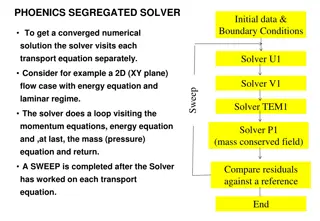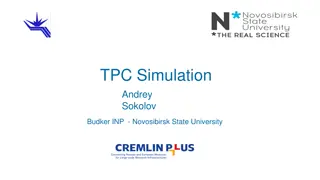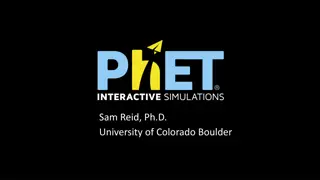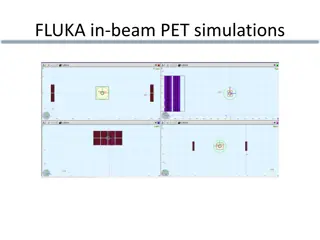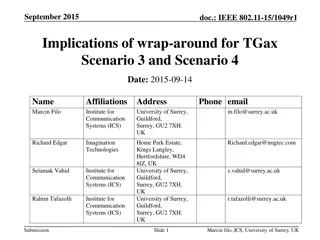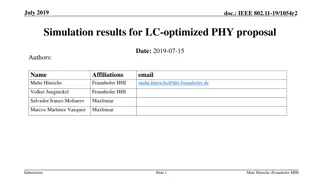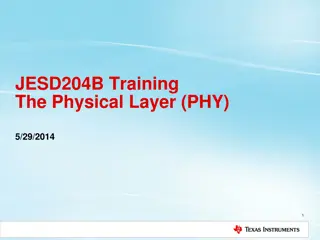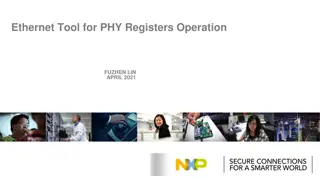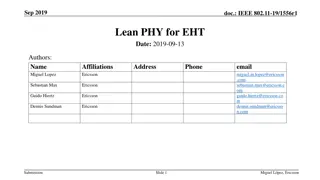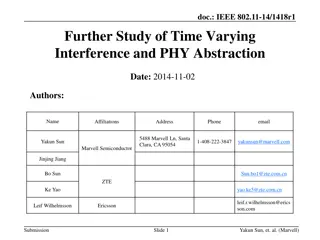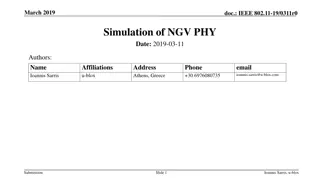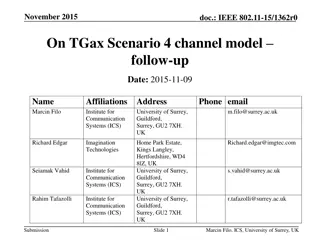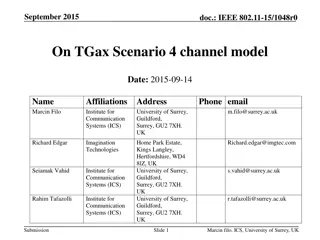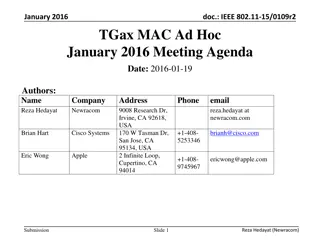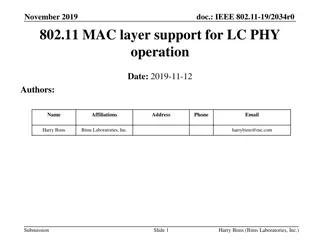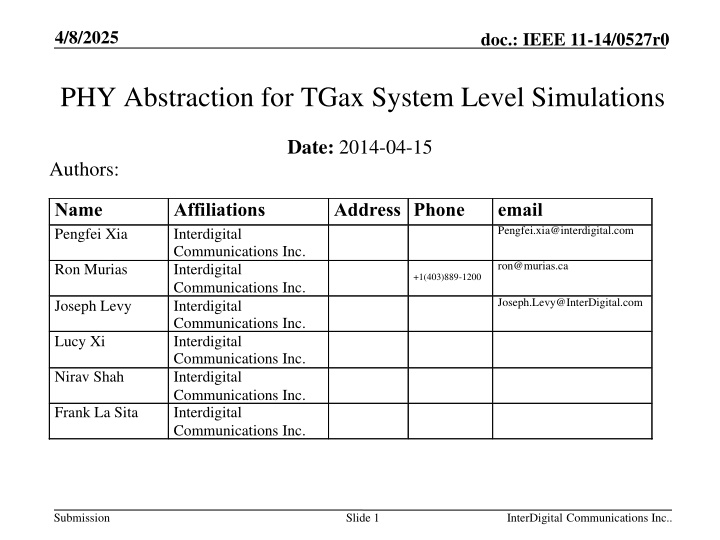
Effective SINR Mapping for TGax System Level Simulations
Explore the innovative approach of ESM (Effective SINR Mapping) for PHY abstraction in IEEE 802.11ax system simulations. The study delves into predicting packet error rates based on channel realizations, leveraging RBIR and LDPC techniques. Discover the MCS-dependent and independent tuning methods for LDPC and BCC in various channels, offering insights into effective SNR versus packet error rate curves.
Download Presentation

Please find below an Image/Link to download the presentation.
The content on the website is provided AS IS for your information and personal use only. It may not be sold, licensed, or shared on other websites without obtaining consent from the author. If you encounter any issues during the download, it is possible that the publisher has removed the file from their server.
You are allowed to download the files provided on this website for personal or commercial use, subject to the condition that they are used lawfully. All files are the property of their respective owners.
The content on the website is provided AS IS for your information and personal use only. It may not be sold, licensed, or shared on other websites without obtaining consent from the author.
E N D
Presentation Transcript
4/8/2025 doc.: IEEE 11-14/0527r0 PHY Abstraction for TGax System Level Simulations Date: 2014-04-15 Authors: Name Pengfei Xia Affiliations Interdigital Communications Inc. Interdigital Communications Inc. Interdigital Communications Inc. Interdigital Communications Inc. Interdigital Communications Inc. Interdigital Communications Inc. Address Phone email Pengfei.xia@interdigital.com ron@murias.ca +1(403)889-1200 Ron Murias Joseph.Levy@InterDigital.com Joseph Levy Lucy Xi Nirav Shah Frank La Sita Submission Slide 1 InterDigital Communications Inc..
4/8/2025 doc.: IEEE 11-14/0527r0 Introduction ESM (effective SINR mapping) for PHY abstraction for 802.11ax: General concept of ESM for PHY Abstraction: 1 N N SINR = 1 SINR n eff = 1 n o Motivation: to predict the instantaneous packet error rate (PER) for the given channel realization o Prior work in 802.11 HEW/ax [3-7] have shown several effective methods o RBIR, RBIR/BICM etc. o We conducted an internal study of a promising mapping method for BCC/LDPC, SISO, over channels B and D Submission Slide 2 InterDigital Communications Inc..
4/8/2025 doc.: IEEE 11-14/0527r0 RBIR (Received Bit Information Rate) ( ) 1 M M M 2 ( ) x ( ) 2 = + log log exp M E U x s s U 2 2 U k m = = 1 1 m k 7 BPSK QPSK 16QAM 64QAM 6 M: number of constellation points for the MCS U: complex Gaussian CN(0,1) random distribution sk: constellation point with normalized energy x: per-tone SINR 5 4 (x) 3 2 1 0 -20 -10 0 10 20 30 40 x (dB) Submission Slide 3 InterDigital Communications Inc..
4/8/2025 doc.: IEEE 11-14/0527r0 Simulation Setup 11ac, SISO MCS 0-6 BCC and LDPC AWGN and Fading Channel B/D 20 MHz, FFT size 64 ESM mapping method: RBIR Tuning Beta = 1; alpha tunable Examined both fixed and MCS-dependent tuning for channels B and D Effective SNR vs. PER curves are compared against AWGN PER curves The closer the better Submission Slide 4 InterDigital Communications Inc..
4/8/2025 doc.: IEEE 11-14/0527r0 MCS Dependent Tuning LDPC, MCS 0 to 6 BCC, MCS 0 to 6 0 0 10 10 Packet Error Rate (PER) Packet Error Rate (PER) -1 -1 10 10 AWGN Channel D Channel B AWGN Channel D Channel B -2 -2 10 10 -10 -5 0 5 10 15 20 -10 -5 0 5 10 15 20 Effective SINR (dB) Effective SINR (dB) MCS 0 1 0.3 1 1 0.2 2 0.9 0.2 3 0.7 0.2 4 0.7 0.2 5 0.5 0 6 0.3 0 (dB, BCC) (dB, LDPC) Submission Slide 5 InterDigital Communications Inc..
4/8/2025 doc.: IEEE 11-14/0527r0 MCS Independent Tuning LDPC, MCS 0 to 6 BCC, MCS 0 to 6 0 0 10 10 Packet Error Rate (PER) Packet Error Rate (PER) -1 -1 10 10 AWGN Channel D Channel B AWGN Channel D Channel B -2 -2 10 10 -10 -5 0 5 10 15 20 -10 -5 0 5 10 15 20 Effective SINR (dB) Effective SINR (dB) MCS 0 0.7 0.1 1 0.7 0.1 2 0.7 0.1 3 0.7 0.1 4 0.7 0.1 5 0.7 0.1 6 0.7 0.1 (dB, BCC) (dB, LDPC) Submission Slide 6 InterDigital Communications Inc..
4/8/2025 doc.: IEEE 11-14/0527r0 Summary PHY abstraction for SISO simulation results for MCS 0-6 RBIR is effective in predicting instantaneous PER results RBIR works more effectively for LDPC than BCC RBIR mapping is generally channel independent Tradeoff between mapping complexity and accuracy If simple mapping is desired, alpha may be chosen as MCS-independent If more accurate mapping is desired, alpha may be chosen as MCS-dependent Results for higher MCS and MIMO to be shown later Need to account for implementation margin Explicit modeling of impairments in SINR definition [LGE, 6] Alternatively, a simple implementation loss in the link budget Submission Slide 7 InterDigital Communications Inc..
4/8/2025 doc.: IEEE 11-14/0527r0 References 1. IEEE 802.16m-08/004r5, IEEE 802.16m Evaluation Methodology Document (EMD) 3GPP R1-040089, OFDM Exponential Effective SIR Mapping Validation, EESM Simulation Results for System-Level Performance Evaluations, and Text Proposal for Section A.4.5 of TR 25.892 . J. Zhang et. al., PHY Abstraction for HEW System Level Simulation , IEEE 802.11-13/1131r0. D. Lim et. al., PHY abstraction for HEW evaluation methodology , IEEE 802.11-13/1059r0. Y. Sun et. al., PHY Abstraction for HEW System Level Simulation , IEEE 802.11-14/0117r0. D. Lim et. al., Suggestion on PHY Abstraction for Evaluation Methodology , IEEE 802.11-14/0353r0. F. Tong et. al., PHY abstraction in system level simulation for HEW study , IEEE 802.11-14/0043r2. S. Vermani et. al, PHY Abstraction , IEEE 802.11-14/0330r3. 2. 3. 4. 5. 6. 7. 8. Submission Slide 8 InterDigital Communications Inc..

